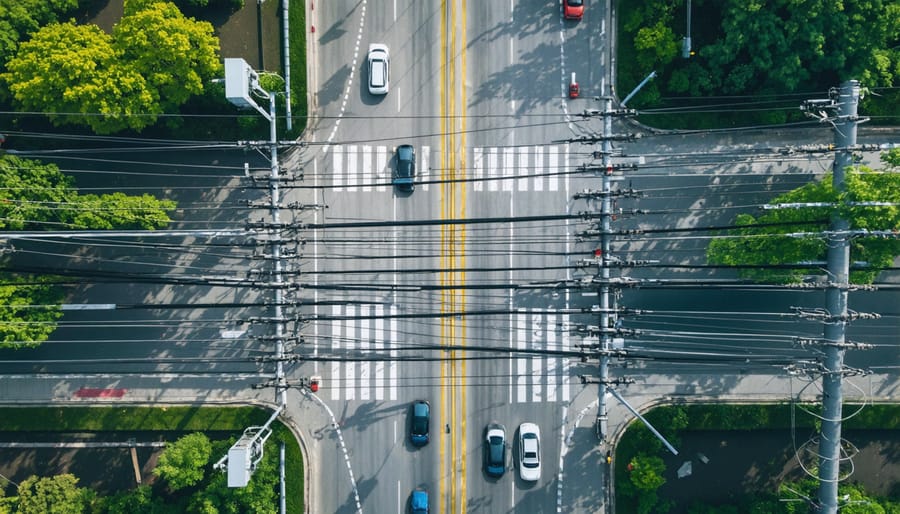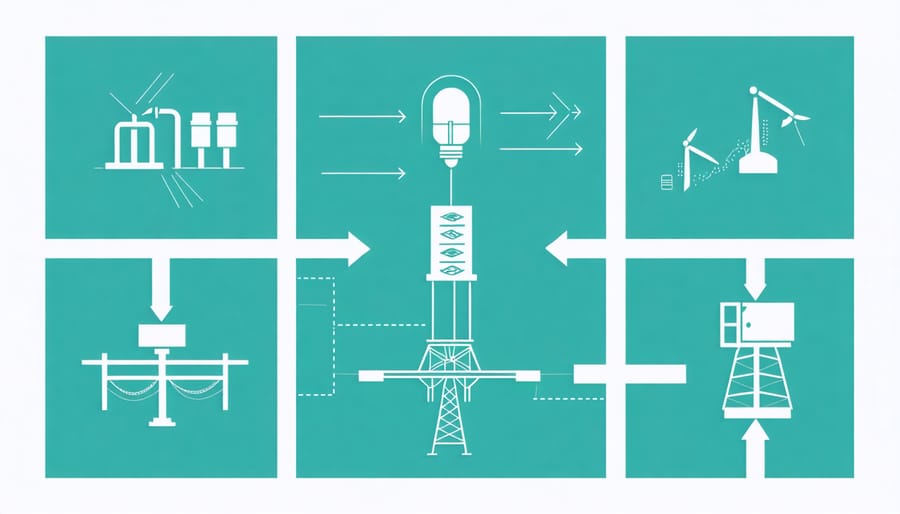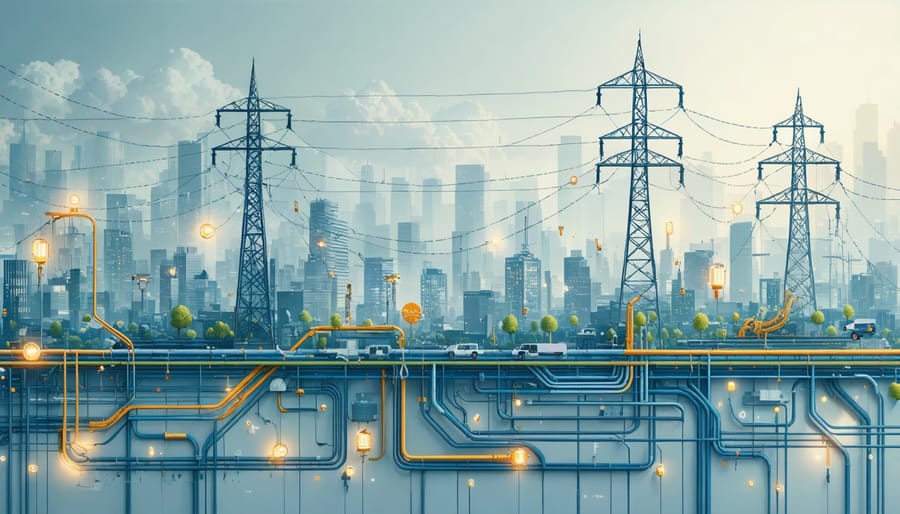Utility infrastructure forms the foundational backbone of modern civilization, encompassing the complex network of systems that deliver essential services to communities and businesses worldwide. From power distribution networks and water supply systems to telecommunications infrastructure and natural gas pipelines, these critical frameworks enable the seamless operation of our built environment. For construction professionals and project developers, understanding utility infrastructure represents a fundamental requirement for successful project delivery and sustainable development.
The intricate interplay between various utility systems demands a comprehensive approach to planning, implementation, and maintenance. Modern utility infrastructure must not only meet current demands but also anticipate future growth while adhering to increasingly stringent environmental regulations and safety standards. This sophisticated network requires careful coordination among multiple stakeholders, including utility companies, government agencies, and private developers, to ensure reliable service delivery and system resilience.
As cities continue to expand and technology evolves, the importance of well-designed and properly maintained utility infrastructure becomes increasingly critical. Industry professionals must navigate complex regulatory frameworks while implementing innovative solutions that enhance system efficiency, reduce environmental impact, and optimize resource utilization. This introduction explores the essential components, planning considerations, and strategic approaches that define modern utility infrastructure development.

Core Components of Utility Infrastructure
Power Distribution Networks
Power distribution networks form the backbone of modern utility infrastructure, comprising interconnected systems of substations, transformers, and transmission lines. These networks operate at multiple voltage levels, from high-voltage transmission lines carrying power from generation facilities to medium and low-voltage distribution systems serving end users. Critical components include primary substations that step down transmission voltages, distribution transformers for neighborhood-level power delivery, and modern smart grid infrastructure that enables real-time monitoring and load management. The integration of automated switching equipment, protective relaying systems, and advanced metering infrastructure ensures reliable power delivery while maintaining system stability and efficiency. These networks must be designed with redundancy and future capacity requirements in mind, particularly in rapidly developing urban areas where power demands continue to grow.
Water Supply Systems
Water supply systems form a critical component of utility infrastructure, encompassing complex networks of treatment facilities, pumping stations, and distribution pipelines. These systems process and deliver potable water while maintaining strict quality standards and ensuring consistent pressure throughout the service area. Recent advancements in modern water infrastructure systems have introduced smart monitoring capabilities, automated treatment processes, and predictive maintenance solutions. Key elements include primary treatment facilities for filtration and purification, elevated storage tanks for pressure regulation, and underground distribution networks equipped with pressure-reducing valves and monitoring sensors. Successful implementation requires careful consideration of population density, topographical variations, and future growth projections to ensure adequate supply capacity and system resilience.
Telecommunications Infrastructure
Telecommunications infrastructure forms a critical backbone of modern utility networks, encompassing fiber optic cables, cellular towers, data centers, and satellite communication systems. This digital infrastructure enables high-speed data transmission, voice communications, and internet connectivity essential for smart city operations and utility management. Underground conduit systems house fiber optic networks, while strategically positioned cellular towers ensure widespread coverage. Network Operations Centers (NOCs) monitor and maintain these systems, ensuring reliable communication between utility components. The integration of 5G technology is revolutionizing telecommunications infrastructure, enabling faster data speeds and supporting the growing demands of IoT devices and smart grid applications. Redundancy and backup systems are crucial elements, protecting against service interruptions and maintaining continuous communication capabilities for essential utility operations.
Gas Distribution Systems
Gas distribution systems form a critical network of high-pressure transmission lines, regulator stations, and local distribution mains that deliver natural gas to commercial, industrial, and residential end-users. These systems typically comprise underground steel and polyethylene pipelines operating at varying pressure levels, with sophisticated monitoring and control systems ensuring safe operation. Key components include city gate stations, which reduce transmission pressure for local distribution, pressure regulation devices, and emergency shutdown systems. Modern gas infrastructure incorporates advanced leak detection technology, cathodic protection systems to prevent corrosion, and remote monitoring capabilities. The network requires regular maintenance, integrity assessments, and compliance with strict safety regulations to maintain reliable service delivery while protecting public safety.

Planning and Implementation Considerations
Regulatory Compliance
Utility infrastructure projects must adhere to a complex framework of federal, state, and local regulations to ensure public safety and operational efficiency. The Environmental Protection Agency (EPA) and Federal Energy Regulatory Commission (FERC) establish foundational requirements, while state public utility commissions oversee implementation and compliance. These regulations encompass environmental impact assessments, safety protocols, and critical infrastructure security measures.
Industry standards, such as those set by the American Society of Civil Engineers (ASCE) and the National Electrical Safety Code (NESC), provide technical specifications and best practices for design and construction. Utilities must maintain detailed documentation of compliance efforts, including regular inspections, maintenance records, and emergency response plans. Non-compliance can result in substantial fines, operational restrictions, and potential liability issues.
Recent regulatory trends emphasize resilience planning, cybersecurity requirements, and environmental sustainability, reflecting evolving challenges in utility infrastructure management. Professional certification and ongoing training programs help ensure workforce competency in meeting these regulatory obligations.
Environmental Impact Assessment
Environmental Impact Assessments (EIAs) play a crucial role in utility infrastructure development, ensuring projects meet sustainability requirements while minimizing ecological disruption. These assessments evaluate potential environmental consequences across multiple dimensions, including air quality, water resources, wildlife habitats, and soil composition. Modern infrastructure projects increasingly emphasize climate resilient infrastructure solutions to address long-term environmental challenges.
Regulatory compliance requires detailed analysis of both direct and indirect environmental impacts throughout the infrastructure lifecycle. Key considerations include carbon footprint reduction, resource efficiency, waste management protocols, and habitat preservation strategies. Projects must demonstrate adherence to local, state, and federal environmental regulations while implementing mitigation measures where necessary.
Infrastructure developers are increasingly adopting sustainable materials and construction methods, incorporating renewable energy solutions, and implementing green infrastructure elements. This approach not only ensures regulatory compliance but also delivers long-term operational benefits through reduced environmental impact and enhanced resource efficiency. Regular monitoring and reporting mechanisms help maintain environmental standards throughout the infrastructure’s operational life.
Cost Analysis and ROI
The financial implications of utility infrastructure development require careful analysis of both initial capital expenditure and long-term operational costs. Industry research indicates that infrastructure projects typically demand 20-30% of total construction budgets, with underground utilities accounting for approximately 15% of these costs. However, proper investment in quality infrastructure systems can yield significant returns through reduced maintenance expenses and extended service life.
A comprehensive cost analysis should consider factors such as materials, labor, equipment, permitting fees, and potential disruption costs. Modern utility infrastructure projects often demonstrate ROI through enhanced operational efficiency, reduced resource waste, and decreased emergency repair requirements. Studies show that preventive infrastructure investments can save organizations up to 40% in long-term maintenance costs compared to reactive maintenance approaches.
Smart infrastructure solutions, while requiring higher initial investment, typically deliver superior ROI through improved monitoring capabilities, predictive maintenance, and reduced downtime. Organizations implementing modern utility infrastructure systems report average annual savings of 12-15% on operational costs and a 30% reduction in emergency repairs. These financial benefits, combined with increased system reliability and reduced environmental impact, make strategic infrastructure investment a cornerstone of sustainable development.
Future-Proofing Strategies
Future-proofing utility infrastructure requires strategic planning that anticipates technological advancements and population growth. Smart grid technologies, renewable energy integration, and digital monitoring systems are becoming essential components of modern infrastructure planning. Industry leaders are implementing modular design approaches that allow for seamless capacity expansion without major system disruptions.
Key strategies include designing oversized conduits and utility corridors to accommodate future cable and pipe installations, implementing scalable SCADA systems for enhanced monitoring, and incorporating renewable energy connection points. Infrastructure planners are also adopting predictive maintenance technologies and asset management systems that use IoT sensors and data analytics to optimize performance and extend system lifespan.
Climate resilience is another critical consideration, with utilities incorporating flood protection measures, underground power line installations, and redundant systems to ensure service continuity during extreme weather events. The integration of microgrids and distributed energy resources provides additional flexibility and reliability while supporting the transition to sustainable energy systems.
Success in future-proofing relies on collaborative planning between utilities, municipalities, and private stakeholders, supported by comprehensive asset management strategies and regular infrastructure assessments.
Maintenance and Upgrades
Preventive Maintenance Programs
Preventive maintenance programs are crucial for maximizing the longevity and reliability of utility infrastructure systems. These programs typically encompass scheduled inspections, routine repairs, and systematic monitoring of critical components across power distribution networks, water systems, and telecommunications facilities.
Key elements of effective maintenance programs include condition-based monitoring, which utilizes advanced sensors and diagnostic tools to detect potential failures before they occur. This proactive approach helps utilities maintain service reliability while optimizing maintenance costs. Asset management systems track equipment performance, maintenance history, and replacement schedules, enabling data-driven decision-making for infrastructure upgrades.
Regular maintenance activities typically include:
– Equipment testing and calibration
– Structural integrity assessments
– Corrosion prevention and control
– Vegetation management around power lines
– Pipeline inspection and leak detection
– Systems optimization and efficiency checks
Industry best practices recommend implementing a risk-based maintenance strategy, prioritizing critical assets and high-risk components. This approach ensures optimal resource allocation while maintaining system reliability. Utilities often develop comprehensive maintenance schedules that account for seasonal variations, load patterns, and equipment age.
Digital technologies, including IoT sensors and predictive analytics, are increasingly integrated into maintenance programs, enabling real-time monitoring and automated maintenance scheduling. This technological evolution has significantly improved maintenance efficiency while reducing operational costs and system downtime.
Smart Infrastructure Integration
Modern utility infrastructure increasingly relies on sophisticated monitoring and control systems that transform traditional networks into intelligent, responsive systems. These smart integrations utilize sensors, IoT devices, and advanced analytics to provide real-time data collection, automated responses, and predictive maintenance capabilities.
SCADA (Supervisory Control and Data Acquisition) systems form the backbone of smart utility management, enabling operators to monitor and control infrastructure components remotely. These systems integrate with smart meters, pressure sensors, and flow monitors to create a comprehensive network that optimizes resource distribution and identifies potential issues before they escalate.
Advanced metering infrastructure (AMI) represents another crucial component, allowing two-way communication between utilities and end-users. This technology enables dynamic load balancing, demand response programs, and more accurate consumption monitoring, ultimately improving operational efficiency and service delivery.
Asset management systems enhanced by artificial intelligence help utilities track infrastructure conditions, schedule maintenance, and allocate resources more effectively. These platforms analyze historical data and current performance metrics to predict equipment failures and optimize replacement schedules.
The integration of Geographic Information Systems (GIS) with smart infrastructure provides spatial context to utility networks, enabling better planning and emergency response. Combined with real-time monitoring, GIS helps operators visualize network status, identify affected areas during outages, and coordinate repair efforts more efficiently.
Cybersecurity measures are essential components of smart infrastructure, protecting these interconnected systems from potential threats while ensuring reliable service delivery.

Case Studies and Best Practices
Several notable utility infrastructure projects demonstrate best practices in planning, implementation, and maintenance. The Singapore Deep Tunnel Sewerage System (DTSS) stands as a prime example of innovative infrastructure development. This comprehensive wastewater management system, completed in 2008, utilizes gravity to transport sewage through deep tunnels, reducing pumping stations and operational costs while serving 2.4 million residents.
In Copenhagen, Denmark, the Cityringen Metro expansion project showcases exemplary coordination of multiple utility systems. The project team successfully integrated existing water, power, and telecommunications infrastructure while constructing 17 new underground stations. Their systematic approach to utility mapping and stakeholder engagement resulted in minimal service disruptions during the five-year construction period.
The Portland Smart Grid Project in Oregon demonstrates effective modernization of existing utility infrastructure. This initiative upgraded the city’s power distribution network with advanced metering infrastructure and automated control systems, resulting in a 30% reduction in outage duration and improved energy efficiency across the network.
Key success factors from these projects include:
– Comprehensive preliminary surveys and mapping of existing utilities
– Early stakeholder engagement and coordination
– Implementation of smart technologies for monitoring and maintenance
– Phased construction approach to minimize service interruptions
– Integration of sustainable design principles
– Regular assessment and updating of emergency response protocols
The Los Angeles Department of Water and Power’s infrastructure renewal program provides valuable insights into managing aging utilities in urban environments. Their systematic approach to identifying and replacing critical infrastructure components has reduced water main breaks by 40% over five years while maintaining service reliability.
These case studies emphasize the importance of long-term planning, stakeholder collaboration, and adoption of innovative technologies in successful utility infrastructure projects. The lessons learned continue to inform best practices in infrastructure development worldwide.
Utility infrastructure remains a critical cornerstone of modern development, demanding increasing attention as urbanization accelerates and sustainability requirements evolve. The integration of smart technologies, renewable energy systems, and resilient design principles will shape the future of utility infrastructure development. Industry professionals must stay informed about emerging trends, regulatory changes, and innovative solutions while maintaining focus on reliability, efficiency, and environmental responsibility. As cities grow and infrastructure needs expand, the importance of comprehensive planning, strategic implementation, and proactive maintenance becomes paramount. The successful development of utility infrastructure projects will continue to rely on collaboration between stakeholders, adoption of advanced technologies, and adherence to sustainable practices, ensuring communities receive reliable services while preparing for future challenges and opportunities.

